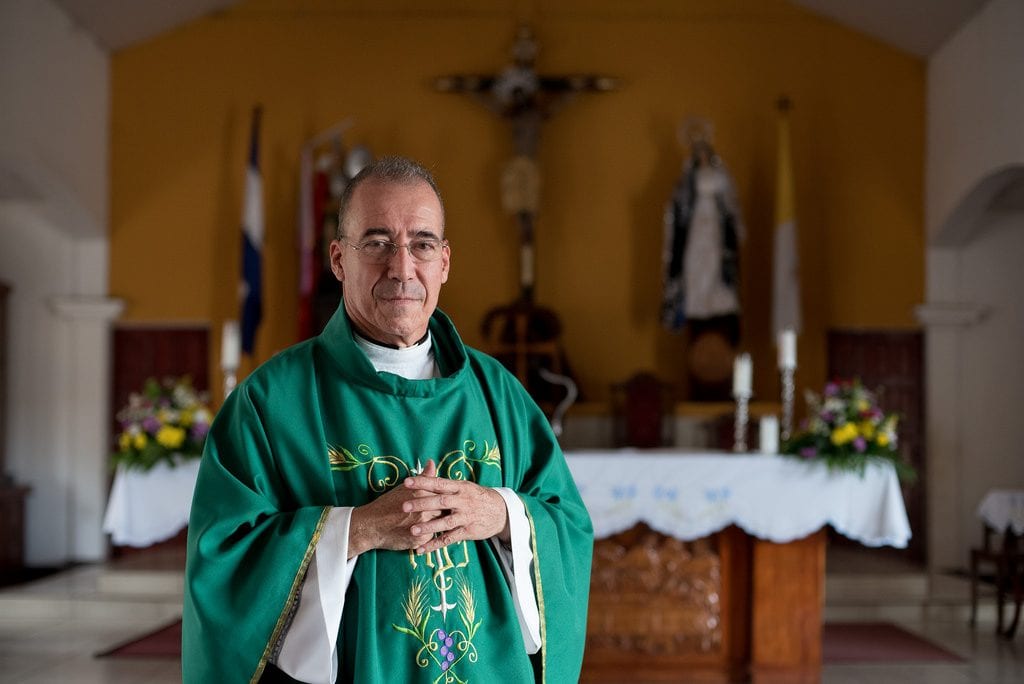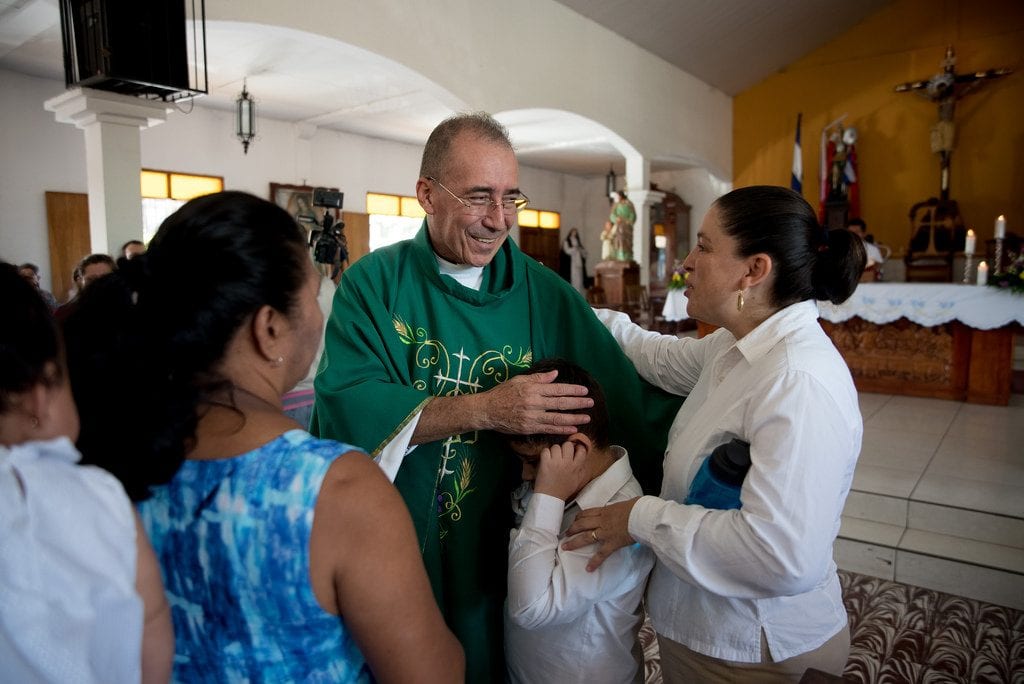Father Edwin Roman: “All Citizens Are Persecuted”

The priest Edwin Roman, and his “mission” to save lives and mediate in Masaya during the repression
A civic hero for people from Masaya. “How is it that a government that calls itself Christian is killing its own people, and is against their rights as citizens?
By Carlos Salinas Maldonado (Confidencial)
HAVANA TIMES – On Sunday, at eleven in the morning, the Saint Michael the Archangel Parrish is so full it could burst. Parishioners arrived early to hear the sermon of Father Edwin Roman, considered in this city a civic hero after having opened the doors of the parish to attend the wounded during the brutal repression unleashed by Daniel Ortega´s paramilitaries against civilians entrenched in barricades, thus challenging the power of the dictator in this city of folklore and handicrafts. Human rights organizations estimate that at least 35 is the number of deaths during to the siege of Masaya by the paramilitaries of Ortega.
Masaya, tense and still occupied by Ortega’s death squads, has in this weekly meeting a relief against the pain caused by sorrow. Parishioners listen carefully to Roman, who is 58 years-old. Some ladies cry, while from his pulpit he criticizes without euphemism or ambiguity those who imprison, kill or blacklist their neighbors. False Christians he calls them and accuses even those that go to mass to tape videos of his sermons. “I like that they tape so that the message reaches them directly and perhaps in this way their conversion will be achieved,” states Roman in reference to Ortega and his wife, Vice President Rosario Murillo.
Roman denounces persecution for his courageous stance and now has precautionary measures from the Inter-American Human Rights Commission. He took refuge in Managua, but last Sunday he decided to return to the city and say mass.
At the end of mass, people line up to talk to the priest, kiss him and hug him. Roman has won the affection of his parishioners and of the city after he risked his life, and became involved in the defense of human rights alongside activists of the Nicaraguan Association for Human Rights (ANDPH) in Masaya.
Tall, thin, his white skin now tanned by the sun and a saddened look, the priest received Confidencial in the church, which is a white wooded building, fresh and modestly decorated. He doesn’t hide his repudiation of the man who has unleashed the worst massacre in Nicaragua during peace times.
He criticizes what he defines as lies, cynicism and manipulation. Not only regarding data, but also Christianity and even Sandino, the national hero of whom Edwin Roman is a direct descendant, because his grandmother, Manuela Calderon, was Sandino’s sister. “The image of Sandino was stolen by Ortega,” he states. “That guerrilla fighter who fought a dictator has now become a dictator. We have seen how he has destroyed his party.”

At the peak moments of the repression, you opened the doors of Saint Michael’s temple. What led you to make that decision?
Edwin Roman: I always remember May 10th, a Thursday. I was in my room and heard shots, explosions and people running and shouting and I did not feel good keeping the door of the priest’s house closed. So, I opened the gate, the doors and immediately began to take care of young people wounded. I gave them water and that night, from seven until three in the morning, we were with neighbors attending the young. The following day there was more repression and there were more than 25 wounded, two of them seriously, who were taken to a private hospital in Managua. And, there were also dead: the first to arrive was a 15 years old boy with an AK-rifle shot in the chest. Afterwards, there were three more people killed. The presbytery became some kind of morgue, people were given refuge and it became a site to present complaints to the ANPDH by mothers who were looking for their children. It became a dispensary with about 14 paramedics and four doctors providing attention.
How was it for you to see dead people here in the priest’s house?
ER: It was very hard. I had faced death many times, when I have to help sick people, but had never seen them in this context, with people that were executed; to see a child shot in the chest, barely 15 years old. As a human being, I broke down in tears. It was very hard to see the image of a mother in a state of shock and there is nothing to do for her son, she wants to awaken him, and touches him, embrace him. Or to see a father kissing his son with tenderness. The mother told me that she used to lock him up in the house and he broke the cabinet to get the key out, because he used to say that he had to go out to defend Nicaragua. It is the heroism of this boy who defended his country with a slingshot. He was cruelly executed by a policeman: the boy was kneeling at the handicrafts market telling the officer “don’t kill me”. But, he was executed in cold blood.
We also saw you in the streets alongside the ANDPH activists interceding for detainees, even during the shootings. What moved you to risk your life?
ER: It was a new mission that the Lord had reserved for me, which I never imagined. I remember that one morning a pick-up truck with paramilitaries passed by and captured eleven young men, and their friends came to ask for my help. That is how I began the mission to mediate the release of those young men. We also interceded in favor of riot police, and people from the Sandinista Youth that according to citizens of Monimbo had infiltrated and were captured. They were brought to the church and along with human rights organizations we liberated them. It was a job of mediation. As a priest, as a pastor, I work for everyone. I do not care about your flag, your political position or your religion. People cannot say we are biased.
President Ortega has accused priests and bishops of inciting violence and has even called them coup mongers. What is your opinion of this attack by Ortega?
ER: No way. We have been on the side of the people. Pope Francis has said that we should not smell of incense but of sheep and that is why we have seen a Nicaraguan church going to the streets. The bishops, the papal nuncio, the cardinal and all the priests that have exposed our lives, but we do it for a mission, a vocation, to be shepherds who give our lives for our sheep. To put our lives at peril is also our duty as pastors, because if Christ shed his blood, we are not exempt from giving our lives for our sheep.

President Daniel Ortega has acknowledged in interviews given to international networks that the deaths in Nicaragua are 197 and has said that most are policemen or Sandinista Front supporters.
It’s cynicism, pure lies. We have seen in the four interviews he has given how he contradicts himself. I have been very close to the ANPDH and they counted 22 dead officers. The rest are civilians. In Masaya we counted 35 deaths, but there was a time in which the data got lost due to the acts of violence. When the people retreated to the lagoon, some of them were wounded and many people laid dead. The people escaped as best they could.
What information do you have about those people who escaped towards the Masaya Lagoon?
ER: There was no support from the government. The Church and the ANPDH were willing to rescue them. We already had the Red Cross, the buses, the nuns from Managua’s Cathedral had food for more than 200 people, because they were going to be moved there, as was done with the boys and girls from UNAN and the Divine Mercy Church. The government did not support it, because they wanted them to return to Monimbo. How would they do it, if they were fleeing the repression of Masaya, of Monimbo, which is their land and they love it? Everyone looked for a way to get out. I have the testimony of a doctor who was there, and pulled a bullet from a young man that was bleeding. There is testimony that there were some dead, there were also twelve years old girls, adults and pregnant women. It was not only people that had been at the barricades, but residents, more than 200 people that scattered in all directions.
In your sermon this Sunday you said: “they are killing us, they are imprisoning us, our neighbors are denouncing us, and that is not being Christian.” However, President Ortega defines himself as Christian…
ER: Imagine! That has been the double discourse since he came to power eleven years ago. However, here we do not see a government that is Christian, because it is killing people. Where is the commandment thou should not kill? How is it that a government that calls itself Christian is executing its people, is mistreating them, is against their rights as citizens? Here entire families were protecting themselves, because the barricades in Masaya gave us protection. Now there is no security. Being young is a crime, being a doctor is a crime, being a priest is a crime.
Do you feel persecuted as a priest?
ER: I am a citizen and like all citizens we are persecuted. All Nicaraguans that want democratization, who want justice for our dead, are considered enemies. I am one of those Nicaraguans that are being pointed out. I had people infiltrated in the parish, people who come to tape. I liked being taped so that they will receive the message directly and perhaps in this way their conversion is achieved.
————-
“Ortega stole the image of Sandino“
“The guerrilla fighter that fought a dictator has now become a dictator. We have seen how he himself has destroyed his party.”

Edwin Roman considers himself a proud descendant of Sandino and criticizes Daniel Ortega’s manipulation of the image of the National Hero. At the beginning of May, he went to Niquinohomo to mediate in the crisis that maintained tense Sandino’s birthplace: inhabitants had rescued the monument of the national hero from FSLN’s control, but Ortega’s supporters wanted to attack the protesters and impose the red and black flag of the party to the statue which stands at the entrance to the village. Roman managed to get from the local mayor, Martha Perez, the commitment that Sandino’s monument was never again going to be held kidnapped by “orteguismo”.
You are a descendant of Sandino. What does “sandinismo” means for you?
ER: Sanino is one and “Sandinismo” is another. I do not doubt that there are good Sandinistas, I have friends that are Sandinistas, but not “Danielistas”. The image of Sandino was stolen by Mr. Ortega. The ideals and his flag, because what has existed in Nicaragua is “Orteguismo”, a “Murillismo” (Murillo, Ortega’s wife and Vice President). I am very proud that General Sandino’s blood runs in my veins.
Do you consider yourself a Sandinista?
ER: I am not a Sandinista militant. My leader is Jesus Christ. My flags are blue and white and yellow and white. I do not have a political party, nor do I have a political leader. I owe myself to the people of God, but I do feel very proud to be a member of Sandino’s family.
The President uses the symbol of Sandino in his speeches and in his Government…
ER: It has been a trampoline. The guerrilla fighter that fought a dictator has now become a dictator. We have seen him destroy his party. The Ortega-Murillo marriage destroyed Sandinismo.
For those readers who understand Spanish:






Comments are closed.